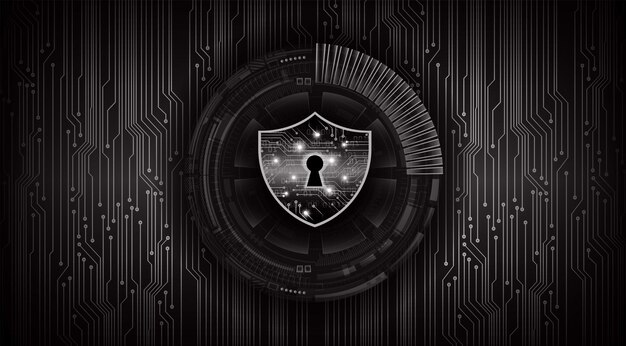Top 5 Cybersecurity Threats for US Small Businesses in 2025

In 2025, small businesses in the US face significant cybersecurity threats including phishing attacks, ransomware, malware, insider threats, and DDoS attacks. Addressing these risks requires comprehensive strategies such as employee training, robust security software, regular data backups, and incident response planning.
Is your small business prepared for the evolving cybersecurity landscape? Discover the **top 5 cybersecurity threats targeting small businesses in the US: prevention strategies for 2025**, arming you with essential knowledge to safeguard your future.
Understanding the Evolving Cybersecurity Landscape
The digital world is constantly changing, and so are the threats that come with it. For small businesses, staying ahead of these challenges is crucial for survival. Understanding the current cybersecurity landscape is the first step towards protecting your valuable assets.
Cybersecurity isn’t just an IT issue; it’s a business imperative. Small businesses are often targeted because they are perceived as having weaker security measures compared to larger corporations.
The Growing Threat to Small Businesses
Small businesses are increasingly becoming prime targets for cybercriminals. Why? Because they often lack the resources and expertise to adequately protect themselves. This makes them an easy mark for various cyberattacks.
Many small business owners believe they are too small to be targeted, which is a dangerous misconception. In reality, cybercriminals often target small businesses as a stepping stone to larger organizations or simply for financial gain.
- Lack of awareness among employees.
- Insufficient investment in security solutions.
- Use of outdated software and hardware.
- Weak password policies.
These vulnerabilities, combined with the increasing sophistication of cyberattacks, create a perfect storm for small businesses in the US.
In conclusion, comprehending the evolving nature of cyber threats is vital for small businesses. Recognizing vulnerabilities and staying informed are essential first steps towards a robust security posture.

Phishing Attacks: The Human Element
Phishing attacks continue to be one of the most prevalent and dangerous threats to small businesses. These attacks rely on deceiving individuals into divulging sensitive information, making them a persistent challenge to combat.
Phishing attacks target the human element of cybersecurity. No matter how advanced your technology is, a well-crafted phishing email can trick even the most vigilant employees.
Recognizing Phishing Attempts
The key to preventing phishing attacks is to educate employees on how to recognize them. Phishing emails often impersonate legitimate organizations or individuals to gain trust.
Common tactics include creating a sense of urgency, requesting sensitive information, or using poor grammar and spelling.
- Verifying the sender’s email address.
- Looking for inconsistencies in the email’s content.
- Being wary of requests for personal information.
- Hovering over links to check their destination.
Regular training and simulations can help employees develop a healthy skepticism towards suspicious emails.
Ultimately, staying vigilant and informed is the best defense against phishing attacks. By educating employees and implementing robust verification processes, small businesses can significantly reduce their vulnerability.
Ransomware: Holding Data Hostage
Ransomware attacks have become increasingly sophisticated and damaging, posing a significant threat to small businesses. These attacks involve encrypting a victim’s data and demanding a ransom for its release.
Ransomware can paralyze a small business, disrupting operations and potentially leading to significant financial losses. It’s no longer a matter of “if” but “when” a business will be targeted.
Preventing Ransomware Infections
Preventing ransomware infections requires a multi-layered approach, combining technical safeguards with employee awareness.
Effective prevention strategies include regularly backing up data, keeping software up to date, and implementing robust security measures such as firewalls and antivirus software.
- Regularly backing up data to an offsite location.
- Implementing a robust patch management system.
- Using strong antivirus and anti-malware solutions.
- Restricting user access to sensitive data.
A well-prepared incident response plan can also help minimize the impact of a ransomware attack by outlining the steps to take in the event of an infection.
In essence, ransomware is a high-stakes threat that demands proactive protection. By implementing a combination of technical safeguards and employee training, small businesses can significantly reduce their risk.
Malware: The Silent Intruder
Malware encompasses a wide range of malicious software designed to infiltrate and damage computer systems. It can spread through various means, including infected websites, email attachments, and removable media outlets.
Malware is often designed to operate silently in the background, making it difficult to detect. It can steal sensitive data, disrupt operations, or even gain control of the infected system.
Detecting and Removing Malware
Detecting and removing malware requires a combination of proactive measures and reactive responses. Regular scans with reputable antivirus software are essential for identifying and eliminating known threats.
Additionally, monitoring network traffic and system behavior can help detect suspicious activity that may indicate a malware infection.
- Using a reputable antivirus solution with real-time scanning.
- Regularly scanning systems for malware.
- Monitoring network traffic for suspicious activity.
- Implementing a firewall to block malicious traffic.
Employee training on safe browsing habits and recognizing suspicious links or attachments is also crucial for preventing malware infections.
To summarize, malware is a persistent and evolving threat. By implementing robust detection and removal strategies, small businesses can protect their systems and data from malicious code.

Insider Threats: Risks from Within
Insider threats are a growing concern for small businesses. These threats involve individuals within the organization who misuse their access to sensitive data or systems, either intentionally or unintentionally.
Insider threats can be difficult to detect because the individuals involved often have legitimate access to the systems they are abusing. This makes it crucial to implement safeguards that can identify and prevent malicious behavior.
Mitigating Insider Risks
Mitigating insider risks requires a combination of technical and procedural controls. Implementing the principle of least privilege, which grants users only the access they need to perform their job duties, can help limit the potential damage from insider threats.
Additionally, monitoring user activity and implementing data loss prevention (DLP) solutions can help detect and prevent unauthorized access to sensitive data.
- Implementing the principle of least privilege.
- Monitoring user activity for suspicious behavior.
- Conducting background checks on new employees.
- Enforcing strong password policies.
Regular audits and reviews of access controls can also help identify and address any vulnerabilities.
In conclusion, mitigating insider threats demands a proactive approach that combines technical safeguards with robust policies and procedures. By implementing these measures, small businesses can significantly reduce their exposure.
DDoS Attacks: Overwhelming the System
Distributed Denial of Service (DDoS) attacks are designed to overwhelm a network or server with malicious traffic, rendering it inaccessible to legitimate users. These attacks can disrupt business operations and cause significant financial losses.
DDoS attacks are becoming increasingly sophisticated, making them more difficult to prevent and mitigate. Small businesses are often targeted because they lack the resources and infrastructure to effectively defend against these attacks.
Protecting Against DDoS Attacks
Protecting against DDoS attacks requires a multi-faceted approach that includes implementing network security measures, using DDoS mitigation services, and having a plan in place to respond to an attack.
Network security measures such as firewalls and intrusion detection systems can help filter out malicious traffic. DDoS mitigation services can provide additional layers of protection by diverting traffic to scrubbing centers where it is analyzed and filtered before reaching the target server.
- Implementing network security measures such as firewalls.
- Using DDoS mitigation services.
- Implementing rate limiting to prevent traffic spikes.
- Having a plan in place to respond to a DDoS attack.
Having a well-defined incident response plan can also help minimize the impact of a DDoS attack by outlining the steps to take to restore service and mitigate the damage.
In essence, DDoS attacks pose a significant threat to small businesses. By implementing robust protection measures and having a well-defined incident response plan, businesses can reduce their vulnerability and minimize the impact of these attacks.
| Key Point | Brief Description |
|---|---|
| 🎣 Phishing Attacks | Deceptive emails targeting sensitive information. |
| 🔒 Ransomware | Malware encrypting data and demanding ransom. |
| 👾 Malware | Malicious software infiltrating systems. |
| 👤 Insider Threats | Risks from within the organization misusing data. |
FAQ
▼
The major threats include phishing attacks, ransomware, malware, insider threats, and DDoS attacks. Each poses unique risks to data and operations, demanding comprehensive security measures.
▼
Employee training is crucial. Teach staff to verify senders, watch for inconsistencies, and avoid providing personal information. Regular simulations can help reinforce vigilance.
▼
Isolate infected systems immediately, report the incident to authorities, and assess data backup options. Never pay the ransom without considering all other recovery possibilities.
▼
Insiders have legitimate system access, making their malicious activities harder to detect. Implementing least privilege access can limit potential damage and enhance security.
▼
Use firewalls, intrusion detection systems, and DDoS mitigation services. A well-defined incident response plan can help restore service and mitigate damage during an attack.
Conclusion
Staying ahead of cybersecurity threats requires vigilance and a proactive approach. By understanding the top threats and implementing effective prevention strategies, small businesses can safeguard their valuable assets and ensure long-term success in an increasingly digital world.